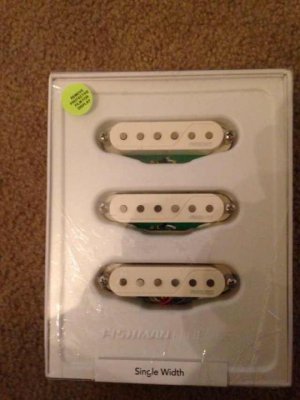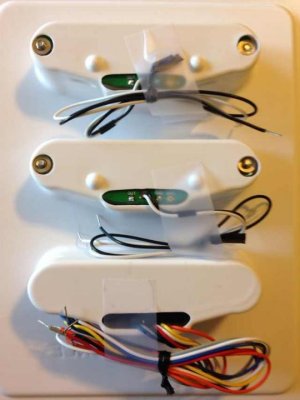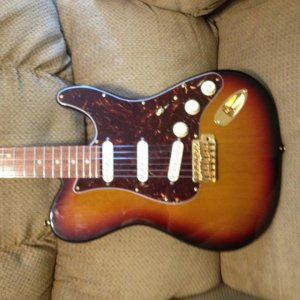Re: Single coil and humbucker sounds out of a pickup. Best way?
Sorry but about 70% of this is good info... The rest is just... Gobbly gook.
If you split a humbucker, you shunt one coil to ground. However, the magnet is still centered between the coils, thus the active coil is not in the center of the magnetic field, which will influence the way current flows.
The first part of this you got right, but the line "will influennce the way the current flows is just bunk. What current? The current is still generated exactly how it was when both coils were on just now the current from one coil is grounded out instead of being passed through the electronics. It doesnt at all change "the way" it flows. Unless you are meaning that it now only flows through one coil but then your line about the coil not being in the center is confusing as nothing has changed and you just typed a bunch of extra words to say that.
Think of it like miking a speaker - if you face the mic so the diaphragm is at the same angle as the cone, you get one tone. Angle the mic at varying degrees and you change that tone. Move the mic closer to the edge or center, and you get still another tone.
Thats an ok analogy.
True single coils typically have magnets running through the coils, which puts the coil wires in the direct center of the magnetic field. Single coils that have a bar magnet across the bottom and ferrous, non-magnetic pole pieces have a different tone than those that have magnetized poles running through the coils. The bar magnet does not transfer its full charge to the ferrous pole pieces, and so the center of the magnetic field is shifted slightly closer to the base of the pickup.
Maybe you should say "stratocaster" single coils. P90s are very much a true single coil in that they have one coil but they certainly dont use rod mags. The magnetic field of a rod mag radiates in all directions, same with a bar mag, You WILL have magnetism that goes above and below the pickup. Rod mags dont have a single direction light saber like magnetic field.
What are you talking about doesnt transfer its full charge, Does it keep half in reserve? Do you understand what a pole piece actually does? A good hint is right in the name.
Now it is true that rod mags and bar mags are different but there are a ton of words here that have nothing to do with nothing.
As well, each magnetic pole piece has its own field, and those fields overlap, which also contributes to the tone. With a bar magnet under ferrous pole pieces, those pole pieces merely serve to extend the bar magnet's field and there is no overlap.
Magnetic pole piece has its own field? or do did you mean to write "rod magnet"?
Umm yes there is magnetic field between pole pieces. Want proof? Bend a string off the pole pieces so its not over any of them. Now it a note... You still hear it dont you. Hell remove the pole pieces which extend the field and you will still hear signal. Weak and faint but its still there. Its a field it doesnt only travel up the pole pieces and shoot out like a laser.
For humbuckers that have coils side by side, the bar magnet is centered between them, and not directly under either one. Ferrous rail blades also do not absorb the full charge of the bar magnet under them, thus splitting such a pickup will not yield the same tone as a true single coil whose pole pieces are magnetically charged.
This is why the StagMag cannot get the same tone as a 59, for example, even if both were wound to the same spec.
Wha... what does any of this have to do with ferrous blades? Why are you introducing a 3rd item here? Why not stick to your original examples of strat singles and humbuckers or if you are going to introduce a 3rd item explain it.
But all that typing could have been said "The stag mag sounds different than a JB cause the stag mag uses rod mags and a JB uses a single bar mag.
Done done and done simple and easy to understand
With stacked single coils, the bottom coil is too far away from the strings to "hear" them, and serves only to act as the inversely-wound coil required to cancel out AC hum. Splitting this type of pickup does nothing except defeat its purpose.
In theory this is true. But in practice it is not. Eric Johnson was famous for not only splitting his HS2's but actually going in and physically clipping the wires so no current flowed to the bottom coil. It actually made the HS2's louder because energy wasnt being lost to resistance in the bottom coil.
For stacked singles that have magnetic pole pieces through both coils, you would get the same tone as a standard true single, but with the hum-cancelling property.
This is not true in the case of most stacked singles on the market. To get the coils to fit in general they are shorter and wider than standard strat singles are (this is how they can stack 2 of them) The shape of the coil does influence the sound. I will say though they are close in tone and sound very good but they are still not 100% the same.
For a stacked single that has a bar magnet under it, you'll get the same tone when split as when not, except you'll also get the AC hum.
Not true as the bar mag under the coils has it generating some signal, even being far from the strings it will still influence the outcome. There is definitely some EQ filtering that goes on with these types of pickups that you can hear the difference between when split and not split.
If you manually reposition the bar magnet of a humbucker under the active coil, you would get a tone similar to that of a single coil with a bar magnet under the ferrous poles.
Wait what? Why do you say manually? is this as opposed to electrically or hydraulically? You say it like its even possible but mechanically on a PAF type humbucker it wont work without a bunch of fabrication. Its not like you can pop it open and slide it over.
BUT the killer here is not the mechanics but you misunderstand that you need a magnetic circuit to create a flow path in a pickup. If we think of a humbucker bar mag as it sits in a pickup the north and south would run parallel to the top and baseplate of the pickup. Single coils that use bar mags the north and south run perpendicular to it. And this is important, Bascially in a humbucker the field flows from one side of the mag into the pole pieces and up through them over the top of the pup and around the strings then the other side pulls that flow down through the other pole pieces and back into the other side of the mag. Its something of a loop or more accurately a cylinder that lays along the long axis of a humbucker.
In your hypothetical you are moving the magnet to one side. It is now no longer in contact with the poles along its north and south edges and you have disrupted this flow path.
This is why the ceramics used in the little series of humbuckers are charged 90 degrees compared to a normal PAF bar mag.
At the end because the magnet would be charged the wrong direction no... no you wouldnt get a similar tone to a strat pup with a mag under it. And lets not ignore that those pups use different sized mags which also influences the tone.
This is when the concept of a thin yet powerful electromagnet comes in: If you could build a pickup that had an electromagnet that was in 3 sections - one under the middle and one under each coil - and you changed which section was active when you changed which coil was active, you would achieve a tone identical to a true single coil that had an electromagnet under ferrous poles.
Wait what? Do you even know what an electromagnet is? If you wrap some copper wire around a steel nail and connect it to a battery you have created an electromagnet. Most use a ferrous core with a wire wrapping and a power source. Now how are you going to mimic the properties of Alnico 5 with a metal core and some copper and a battery?
Assuming one could create an electromagnet that was identical to a traditional sintered magnet, the tones would be identical.
Thats a huge assumption to make, BTW most mags are not sintered most are cast. The particular properties that make up the difference between an A2 and a A5 would be difficult at best to replicate with a electromag. How are you going to replicate the difference between a rough cast and a polished? You can vary the energy you put to the electro mag but the peculiarities would be hard if not impossible to do.
Assuming further that one could wrap coil wires around such a magnet shaped like a rail blade, you would get a tone drastically different from a railed single with a bar magnet under the rail.
Ok let me see if i got this... so you have a ferrous core... that is wrapped with wire to create your electro mag. THen you are going to wrap it with more wire to create your inductor? okaaayyyy.... Well i will agree here that it would sound drastically different.
Sorry but most of your post could have been much more clearly and succinctly put that due to the differences in physical shape and location it is difficult if not impossible to make a split PAF type humbucker sound like a strat single coil.
I say it like this cause Rio Grande sells humbuckers that are literally 2 strat single coils on a baseplate. Split, other than a possible mismatch in location under the strings they sound 100% like their single coil brethren because they are. In humbucker mode they do not sound like PAF's but they do sound like humbuckers.
Thats enough typing for now... I'm gonna go stab someone thousands of times with a needle



